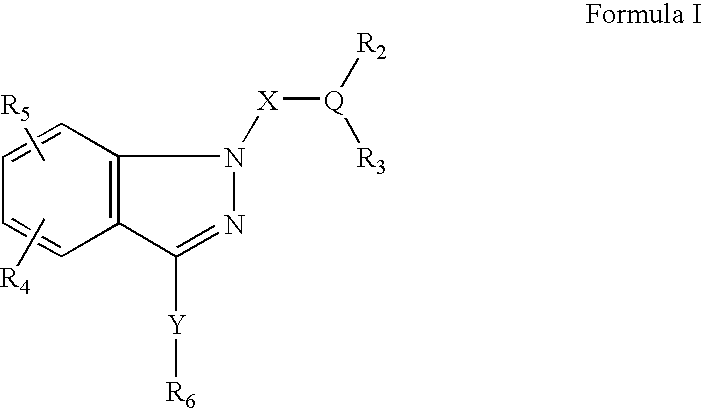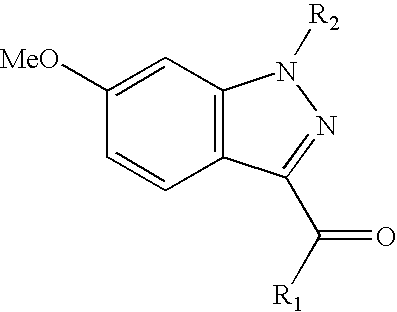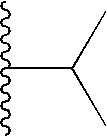Ophthalmic compositions for treating ocular hypertension
a technology of ocular hypertension and compositions, applied in the field of ophthalmic compositions for treating ocular hypertension, can solve the problems of unsatisfactory side effects, unsatisfactory efficacy and unsatisfactory side effects of these agents, and irreversible loss of visual function
- Summary
- Abstract
- Description
- Claims
- Application Information
AI Technical Summary
Benefits of technology
Problems solved by technology
Method used
Image
Examples
example 1
[0130]
[0131]Indazole (0.55 mmoles from Preparative Example 3) starting material obtained as above was dissolved in DMF (3 mL) followed by the addition of sodium hydride (0.88 mmoles). The reaction was stirred at room temperature for 15 min, followed by the addition of 1-bromo-pinacolone (0.669 mmoles). The reaction was stirred at room temperature for 30 min. TLC and LC-MS analysis indicated complete consumption of starting material concurrent with the formation of a new product spot. The reaction mixture was quenched by the addition of water. Standard aqueous work-up followed by purification of crude by SGC gave the desired product as white solid.
[0132]1H NMR CDCL3: 8.3 (3H, m); 7.61 (1H, t, J=7.5 Hz); 7.52 (2H, dd, J=7.5 and 7.0 Hz); 7.04 (1H, dd, J=2 and 9 Hz); 6.56 (1H, d, J=2 Hz); 5.4 (2H, s); 3.94 (3H, s); 1.4 (9H, s). LCMS [M+H]=351.
example 2
[0133]
[0134]Indazole (0.60 mmoles from Preparative Example 4) starting material obtained as above was dissolved in DMF (3 mL) followed by the addition of sodium hydride (0.88 mmoles). The reaction was stirred at room temperature for 15 min, followed by the addition of 1-bromo-pinacolone (0.669 mmoles). The reaction was stirred at room temperature for 30 min. TLC and LC-MS analysis indicated complete consumption of starting material concurrent with the formation of a new product spot. The reaction mixture was quenched by the addition of water. Standard aqueous work-up followed by purification of crude by SGC gave the desired product as white solid.
[0135]1H NMR in CDCL: 8.22 (1H, d, J=9 Hz); 6.97 (1H, dd, J=2 and 9 Hz); 6.5 (1H, d J=2 Hz); 5.4 (2H, s); 3.94 (3H, s); 2.8 (1H, m); 1.38 (9H, s); 1.27 (6H, d, J=6.5 Hz). LCMS=[M+H]=317
example 3
[0136]
133 mg of indazole from Preparative Example 4 was dissolved in dry DMF (3 mL), followed by the addition of sodium hydride (24.3 mg, 60% oil dispersion). After stirring at room temperature for 15 min. 0.2 mL of 2-ethyl-hexyl iodide was added. The reaction mixture was allowed to stirr for an additional 10 h. Upon standard aqueous work-up followed by purification by SGC the desired product was obtained.
[0137]1HNMR CDCL3: 8.22 (1H, d, J=8.5 Hz); 7.0 (1H, dd, J=8.5 and 2 Hz); 6.75 (1H, d, J=2 Hz); 4.23 (2H, d, J=7.5 Hz); 3.9 (3H, s); 2.2 (1H, m); 0.8–1.5 (15h, m). LCMS [M+H]=331
[0138]Examples 4 through 15 as shown below are made, with some modification of the desired compound of Example 3, by alkylation of the indazole as described in Example 1. Additionally, analogs of Examples 1 and 4–15 can be prepared following analogous procedures using the indazole of Preparative Example 4 or alternatively another indazole prepared following procedures described herein.
PUM
| Property | Measurement | Unit |
|---|---|---|
| temperature | aaaaa | aaaaa |
| temperature | aaaaa | aaaaa |
| temperature | aaaaa | aaaaa |
Abstract
Description
Claims
Application Information
 Login to View More
Login to View More - R&D
- Intellectual Property
- Life Sciences
- Materials
- Tech Scout
- Unparalleled Data Quality
- Higher Quality Content
- 60% Fewer Hallucinations
Browse by: Latest US Patents, China's latest patents, Technical Efficacy Thesaurus, Application Domain, Technology Topic, Popular Technical Reports.
© 2025 PatSnap. All rights reserved.Legal|Privacy policy|Modern Slavery Act Transparency Statement|Sitemap|About US| Contact US: help@patsnap.com



